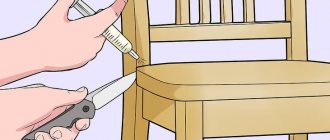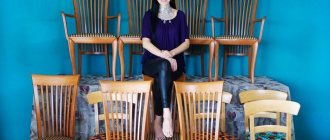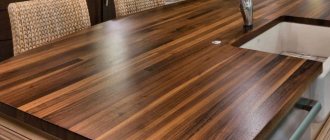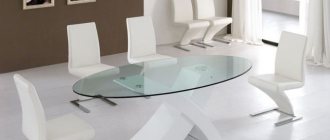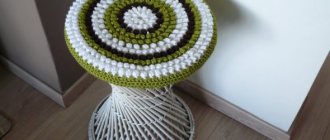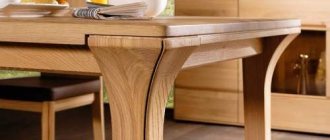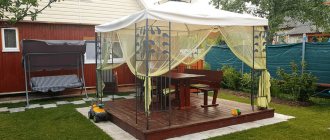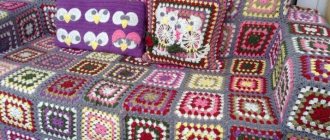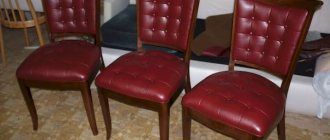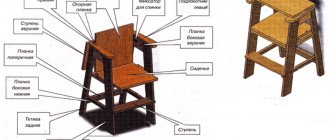Wooden furniture, in particular chairs, is an element that complements the interior of probably most residential premises. Many of them are not only functional, but also aesthetically pleasing. Unfortunately, wooden products, unlike those made from artificial materials, consist of a large number of elements and tend to become loose, begin to creak, or may even fall apart. There is no need to rush to get rid of them and send them to a landfill. Often, all you need to fix and continue to use your favorite chair is some glue and a couple of simple tools.
How to glue a chair leg step by step
Most of the parts of a wooden chair, including the legs, are connected to each other using glue.
Over time, such seams tend to weaken and dry out, which is why very often chairs break. But don't despair about this.
To solve the question of how to properly glue a chair leg , it is enough to acquire the necessary tools, namely:
- A hammer with a rubber tip;
- Sandpaper;
- Durable adhesive intended for furniture;
- Press;
- With a sharp knife or chisel.
When these devices are prepared, you can begin the main process of gluing the chair legs. Furniture with a simple design is not particularly difficult to repair; it is only important to follow the steps in the work:
- First, you need to remove the wobbly leg from the socket, and its upper part, which is inserted into the groove (trunnion), should be cleaned of dried glue. If the previously applied glue is difficult to remove, you can steam it with water steam.
- If there is a thin layer of glue on the chair, it can be removed using sandpaper, and if it is thicker, you must first remove the layer of glue using a chisel or a sharp knife, and then sand the surface itself.
- After this, you need to apply a layer of glue to the pin, and also insert it into the seat socket. If the cord leg does not fit well into the socket, it is recommended to knock on it with a hammer equipped with a rubber nozzle. It is also allowed to apply some kind of press to the part.
- Visible adhesive residues should be removed using a piece of cloth.
- After 24 hours, when the glue is completely dry, you can use the chair.
Only by correctly gluing the chair leg can you count on its reliability and strength in the future. Without following simple rules, some tricks, desire and without resorting to the help of certain tools, it is simply impossible to achieve a positive result.
Review of the best adhesives for wooden chairs and furniture
Glue is the best tool for repairing wooden furniture. By adhering to the instructions written on the packaging and taking into account all the gluing requirements, everyone has the opportunity to achieve the effect with their own hands and make the gluing area more reliable and durable than the wood itself.
The following types of glue are used mainly for repairing furniture and, in particular, wooden chairs:
- PVA. This glue is resistant to temperature changes, easy to use and leaves no marks at all. It must be applied to a degreased surface and pressed at the junction. Complete drying should be expected after 24 hours;
- Casein glue. It often changes the color of the wood and is distinguished by its strength, but in places where it is glued it can leave a noticeable mark. The glue is a light powder that is diluted in water until it becomes thick sour cream, after which it is recommended to mix it with water for about 40 minutes. Dried glue is more resistant to temperature changes;
- Synthetic glue. This type of glue is used even on an uncleaned surface and is characterized by good frost resistance, moisture resistance and strength;
- Wood glue. It differs from other types of glue in its incredible strength and resistance to temperature changes. Almost always, its quality depends on the correct preparation process, which involves maintaining proportions when mixing it with cold water.
And although the modern market is able to offer customers a wide range of companies that produce glue, you must first familiarize yourself with the characteristics of a particular product in order to subsequently make the right purchase.
Possible mistakes
Often, after gluing, furniture continues to sway and squeak. If the chair falls apart, the procedure was carried out in violation of technology. Let's look at the main culprits of the problem.
The composition has not dried
The drying time of most modern adhesives is up to 24 hours. Even if the manufacturer promises availability on the label in 30 minutes, this is a setup period. The composition gains strength within 24 hours after application.
External factors may prevent the adhesive from curing. Products dry slowly at low temperatures and high humidity. If you need to quickly make repairs, in the cold season it is better to move the furniture to a warm room after gluing.
Violation of technology
To ensure that the glue adheres well, the surface is prepared before application. Old residues are removed from the wooden chair parts and then degreased with alcohol. Professionals recommend making small cuts with a knife in the transverse plane of the spine. The method will make it easier to join the parts.
The glue may dry before the connectors touch. Wood absorbs excess moisture, especially indoors in hot summers or heat. If the performer maintains the composition, the product does not have time to act on the surface.
The glue won't stick if it's loose. In order for a wooden chair to stick, the structure must be secured. Carpenter's clamps (collars) or rubber bands will help hold the parts in place. The structure is dismantled one day after treatment.
Glue should not get into the seams. To glue a wooden chair, it is necessary to dismantle the problematic part and adjacent elements. The mass should penetrate accurately and generously into the furrow and tip. Without dismantling, even the most durable composition will not cope with the task.
The product was chosen incorrectly
If the mass does not stick, it means that the wrong glue was used for the wooden chair. Universal compounds also have a list of surfaces with which they work. A leather, glass or plastic cleaner will not necessarily restore wood. You should not experiment with building materials - it is prohibited to use polyurethane foam or grout for furniture tiles.
Kinds
The greatest demand now is for PVA, polyurethane compounds and resin-based mixtures. They differ significantly from each other.
Features of popular adhesives for wood furniture:
- PVA – this name hides a polyvinyl acetate dispersion. This substance is non-toxic, so it can be used indoors for repairing wooden products. It is waterproof, affordable, and very easy to work with.
- Resin mixtures are especially popular among woodworkers and homeowners. Epoxy compounds provide reliable adhesion to surfaces made of wood and other materials. The substances are not afraid of moisture and aggressive chemical elements.
- Polyurethane adhesive can withstand fairly high loads; it is especially suitable for use on wooden furniture legs. The glue can be used in extreme conditions.
When choosing a product for wood, you need to consider the following points:
- Connection density.
- Toxicity level.
- The period of complete hardening.
- Moisture resistant.
- Seam strength.
PVA
PVA glue is considered to be a stationery glue, but it is also successfully used when working with wood. This is a safe and high-quality product that not only reliably connects surfaces, but is also able to withstand high humidity and liquids for a long period.
Woodworker PVA is considered the best adhesive for wood. With its help, you can glue different types of wood together and with building materials such as chipboard, plywood, MDF.
For reliable setting after joining, the parts must be pressed tightly against each other for half an hour. Complete hardening of the composition, when the parts can already be used, occurs within 24 hours. This wood adhesive composition does not change the color of the wood and does not disturb its structure. Operation is possible under conditions from 5 to 30 degrees.
Reference! Woodworkers and home craftsmen note that this composition is excellent for wood due to its quick setting, strength and accessibility.
KLEIBERIT is a waterproof PVA composition with universal characteristics. They can be used to connect wood with other surfaces. What sets it apart is its ability to glue exotic woods.
After drying, this glue turns white. It can withstand temperatures from -30 degrees. It is chosen for its setting speed, frost resistance and resistance to liquids. The downside is the importance of strictly following the instructions.
Wood glue
Wood glue is based on aliphatic resins. The material is used for joining wooden products - home and outdoor furniture. One of the best would be bone glue, which is great for antiques.
After applying this glue, you need to dry it under pressure for some time. Alcohol can be used to disassemble the connection.
Syndeticone
Syndeticone glue is prepared from carpentry by adding lime and powdered sugar. The material has an increased level of structural adhesion. It is waterproof and resistant to chemicals.
Reference! The disadvantage of such a product for wood will be the long manufacturing process. To obtain good glue, you will need to soak it in liquid for 24 hours.
Glue BF
Thermosetting or BF adhesive composition connects elements when exposed to high temperatures.
It can be single- or multi-component. The first option can be purchased ready-to-use. Multicomponent glue must first be prepared by mixing several substances.
BF can be inorganic, organic and organoelement. Available in liquid, dry and solid form. Water-based products take longer to harden, which must be taken into account when choosing, but substances with solvents set almost instantly.
Epoxy resin
Epoxy resin glue is good for gluing wood together. It's also great for filling gaps. It is waterproof and has optimal strength characteristics.
The glue is two-component, that is, it consists of a resin and a hardener. To prepare, they need to be mixed in a certain proportion, as indicated in the instructions. The positive side is that this furniture glue does not shrink.
Reference! Different ratios of elements give the glue different properties, which can be controlled under certain conditions. What’s also good is that gluing does not require long pressing.
Urea resin
Urea resin adhesive is prepared from thiourea or synthetic urea through a heating process. Such compositions create very strong compounds of wood products. They are resistant to moisture and can be used in extreme conditions.
This glue is acid-curing, and after mixing with a hardener its service life is short - up to 4 hours. It is used for hot pressing.
Reference! This glue is transparent, which is very beneficial when gluing wooden furniture.
Polyurethane glue
When high strength, resistance to liquids and mechanical loads are important, you can safely opt for polyurethane adhesive.
A well-known representative is Soudal 66 A, produced in Belgium. It can be used in harsh environments to bond wood products even if they are wet. It is compatible with most building materials.
Reference! When hardened, the composition foams, which allows it to fill all seams and cracks.
Polyurethane wood adhesive mixture can be used for complex carpentry work indoors and outdoors. They love it for its excellent strength, water resistance, and reliable grip.
Kleiberit 501.0 is another polyurethane composition, but from a German manufacturer. This is a good universal furniture adhesive that is not afraid of high temperatures and moisture. Can be used when combining different materials.
The adhesive receives good reviews due to its convenient use, flawless connection and optimal consistency. When working with it, it is important to ventilate the room and protect the skin.
Liquid Nails
Liquid nails are a good option for furniture. They consist of polymers and rubber. The material is distinguished by its plasticity and strong connection. This is an alternative to conventional nails when work needs to be done quietly and cleanly. The composition may also contain solvents.
Advantages of using liquid nails for furniture:
- High strength - this glue can withstand up to 80 kg per cm;
- The mixture does not disturb the surface structure.
- Can be used to connect uneven substrates.
- Not subject to corrosion.
How to glue wooden furniture?
If a chair leg or a computer desk panel breaks, it’s not a problem. Can be fixed at home. Quite often there is a need to make minor furniture repairs. For example, there is a need to re-glue wooden parts on chairs, armchairs, half-chairs and other furniture. Many people have the bad habit of sitting on chairs and rocking on them, which causes the furniture to become loose and fall apart. Bonding is the main type of connection in furniture repair and manufacturing. Solid wood structures are more susceptible to warping than structures that are glued together. In addition, adhesive structures have fairly high strength and do not weigh down the structure as a whole. Collagen, epoxy, and casein adhesives are used for gluing furniture pieces.
Such well-known adhesives as: PVA, “Moment”, “Bustilat” are also used. The quality of adhesive joints depends not only on the selected adhesive, but also on many technological factors of the gluing process
Wood surfaces intended for gluing must be well treated. Scratches, pins, marks from jagged knives, marks from feed grooved rollers, as well as oil stains impair the quality of gluing. The wavelength on the planed surface intended for gluing should not exceed 3-4 mm for hard rocks and 5-6 mm for soft rocks. Wide workpieces and panels should be planed on thicknessing machines to ensure strict parallelism of the faces.
To avoid warping of the workpieces before gluing, it is recommended that planing be carried out immediately before gluing.
After drying, the workpieces intended for gluing must be kept for some time to equalize the moisture content of the wood. The best wood for gluing is with a moisture content of 7-10°/o, and for plywood and veneer about 5%.
Good results are obtained when gluing smooth surfaces. Surface treatment does not increase the bonding strength; it can only be recommended when using very liquid adhesives.
For a good quality glue joint, it is necessary that the parts of wood to be glued be subject to pressure.
Pressure is carried out through the use of a number of devices. The simplest of them are clamps and various screw devices. Currently, pneumatic devices operating with compressed air are widely used, and in powerful press installations, hydraulic pumps operating on liquid are widely used.
In order to improve the quality of gluing and speed up the process, the glued plots or the adhesive seam are heated.
Heating is carried out using narrow long metal strips through which a low voltage and high power current is passed. In hydraulic presses, heating is carried out by contact from hot, steam-heated press plates, on which the workpieces to be glued are placed. In addition, there are presses in which heating occurs as a result of the formation of an electric field between electrodes powered by a high-frequency generator. With this method, not the entire mass of wood is heated, but only the glue joint.
Gluing with wood-gelatin adhesives. Glue is applied to large flat surfaces (boards, veneer, etc.) using glue-spreading machines. When manually spreading large surfaces, use bristle brushes, while small surfaces use bast brushes. The adhesive solution should be applied in an even layer with a thickness of about 0.08-0.15 mm.
Before pressing the workpieces to be glued, it is recommended to keep them for some time with the glue applied. There are open and closed shutter speeds. Open dwell time is the time between applying glue to the surfaces to be glued and joining them together. Closed exposure is the period after joining the bonded surfaces until
pressing moment. Aging helps the adhesive solution absorb into the wood. In addition, during open curing, partial release of moisture occurs and the concentration of the adhesive solution slightly increases, resulting in less moisture in the wood. Open exposure has the most beneficial effect when using liquid glue.
At low temperatures in the workshop, open holding can lead to premature hardening of the glue, which should not be allowed. The air temperature in the gluing shop when using gelatin glues should not be lower than +18°; pressing pressure is from 3 to 8 kg/cm-.
The consumption of adhesive solution when veneering 1 m2 of surface is 300-350 g.
Bonding with casein glues. In the furniture industry, casein glue is used in the cold gluing method. The casein glue solution should be prepared for 4-5 hours. work, since with longer storage it thickens and becomes unsuitable for consumption.
You can apply casein glue to the surface to be glued with brushes (preferably bast). For a large number of jobs, glue is applied using glue-spreading machines with grooved rollers. Apply glue to only one of the surfaces to be glued.
For half-end and tenon joints, the duration of exposure under pressure (in clamps, clamps, clamps) is 6-8 hours, and the duration of exposure of parts after pressing is 6-12 hours.
When gluing wood on the edge and on the face, the duration of exposure in the press is 2-3 hours, and the duration of exposure of the parts after pressing before further processing is 20-24 hours.
The consumption of casein glue when veneering 1 m2 of surface is 350-500 g.
One of the disadvantages of casein glue is the rapid dulling of the cutting tool when processing materials glued with it due to the presence of solid calcium salts in the adhesive joint.
Bonding with synthetic adhesives. The use of synthetic adhesives during gluing and veneering in hot presses can significantly reduce the holding time of workpieces under pressure. In practice, the holding time in hot presses is 5-20 minutes, i.e., several times less than the holding time under pressure when gluing with carpentry gelatin or casein glues. Pressure during pressing, depending on the nature of the workpieces glued with synthetic glue, ranges from 3-12 kg!cm.-.
Often special conditions are created for aging: closed rooms with a certain temperature and air humidity. The duration of exposure, depending on the nature and purpose of the workpieces, is from 24 to 50 hours.
When gluing with foamed synthetic adhesives, the pressing mode for veneering panels is recommended as follows: pressure 10 kg/cm2, press plate temperature 90-110°, pressing duration 7-8 minutes.
Types and characteristics of glue: which one to choose
The most important characteristic when choosing an adhesive is the strength and durability of the connection; it is this factor that should be taken into account first. It is also worth paying attention to toxicity (especially if there are children in the house), resistance to environmental influences and the presence of traces after processing. The appearance of the product can be spoiled by incorrectly selected glue.
Several types of glue are used to join wooden furniture parts, the most popular of which are:
- PVA (polyvinyl acetate), and others based on it. It is time-tested, reliable, absolutely non-toxic and environmentally friendly. The advantages also include low cost, accessibility, and no need for special preparation before use.
- Syndeticone adhesive is characterized by increased resistance to physical stress, chemicals and liquids. Its disadvantage is the very long preparation process before application (about a day before dissolution).
- BF is characterized by excellent moisture resistance and resistance to low temperatures. Its drying time is about 1 hour, which makes working with it more convenient. Disadvantages include poor adhesion of non-greased and poorly treated surfaces.
- Epoxy adhesive has very high bond strength and resistance to a wide range of aggressive reagents. It is good because it has high versatility and can be used in many places in everyday life. A minor drawback is the increased consumption (it may not be all consumed, and after mixing the components it cannot be stored).
- Polyurethane adhesive copes better with dynamic loads than others. Excellent resistance to environmental influences and chemical reagents.
REFERENCE! As a substitute for expensive polyurethane, you can use regular polyurethane foam. To do this, you will first need to knock it down with a hard object, such as a spatula, to get rid of air bubbles. The connection made with it will be very strong and able to withstand enormous loads.
Wood gluing tool
To obtain the most durable connection, when gluing, the wood is pressed - subjected to compression using special presses. At home, improvised tools and means are used for these purposes - vices, clamps, cam devices, frames made of metal corners with clamping mechanisms. The pressure when pressing wood is maintained in the range from 0.2 to 1.2 MPa. In production, large values are possible; at home, such indicators are enough for the structural parts to stick together.
If the gluing technology is followed, the adhesive seam is strong and reliable, and, unlike the method of joining parts with metal fasteners, it does not spoil the appearance.
For those who like to create household items on their own, FORUMHOUSE has opened a topic about furniture for home and garden. You can find out how to organize a convenient corner for working with wood in the article about arranging a carpentry workshop. The video about wooden elements in a country house shows interesting products made by users of the portal.
Epoxy
Epoxy glue is universal, capable of gluing any surface, including wood. It can smooth out unevenness, quickly filling all cavities.
The material is a two-component mixture consisting of resin and hardener, which does not require preheating before application.
Basic properties:
- heat resistance;
- elasticity;
- completely waterproof;
- immunity to aggressive environments;
- good adhesion;
- resistance to cracking.
Epoxy compounds have disadvantages. The main disadvantage is the high hardening speed.
You need to work with the composition quickly and accurately. It must be borne in mind that if mistakes are made, it will be impossible to correct them.
Basic requirements for the adhesive composition
To achieve maximum strength and reliability of fixation, you should purchase an adhesive with the optimal composition. Components are selected taking into account the following criteria:
- Resistance to elevated temperatures. This is required when using items in open areas, near heating sources, gas and electric stoves.
- Resistant to weight load. Typically, this parameter is recommended to be taken into account when fixing the legs of tables, shelves of cabinets, seats of sofas or chairs.
- Vibration resistance. This parameter is important when placing products near generators, washing machines and other equipment.
- Chemical resistance. This is true for items that have to be washed frequently with household chemicals. They can be located in the kitchen, toilet or bathroom.
- the melting point should be 80-100 degrees;
- operating temperature of hot melt adhesive is 120-200 degrees;
- hardening time is 5-40 seconds - it all depends on the composition of the substance.
Directly re-gluing chairs
After you have cleaned the tenon joints, you can begin gluing directly.
Important! PVA glue takes quite a long time to dry, but fortunately the time required for it to harden is indicated on the label.
Proceed as follows to glue a wooden chair:
- Securely fasten all your glued parts so that they are pressed directly against each other with the necessary pressure.
- To securely fasten the glued parts, a clamp or special tension belts are used.
- To ensure that the varnished surface of the wood is not damaged after this and that no marks remain on it, be sure to use spacers.
Important! You can use wooden blocks or thick rubber as spacers, but fabric will not work.
- You will need a small number of clamps to secure all the parts. Using straps, you can secure several sides at the same time, which is incredibly convenient.
Important! Check the tension of all belts until the adhesive solution has completely cured. If they become loose, tighten them immediately.
Causes of breakdowns
Before you look for how to glue a wooden chair together, you need to understand what caused the breakdown. This type of furniture consists of many parts that are attached with glue. Over time, the joints become unstuck. It happens that the legs move away from the harness. They are usually attached using spikes.
Some products may have manufacturing defects. A man sits on a chair with wooden legs and falls because one of the legs falls off. Don’t think that furniture is no longer usable and should be in a landfill. Breakdowns of this type can be easily repaired with your own hands without spending a lot of money on repairs.
Advice from the experts
Before starting work, you need to prepare the necessary tools, clean the surfaces that will be glued and carefully study the instructions.
Reference! After gluing, it is important to press the elements for a while to ensure reliable adhesion. This must be done for at least 10 minutes.
When you need to glue it together forever, synthetic glues are better suited, but if you need to further disassemble the furniture, you should use a natural one, like casein or bone glue.
For light types of wood, it is better to use Joiner glue, which adapts to the shade of the material. Casein glue is contraindicated in this case.
When choosing PVA glue, you need to pay attention to the consistency. If it is too liquid, you should not take it, because this indicates hypothermia, which has a bad effect on the adhesive ability.
When choosing glue, it is better to give preference not to universal, but to special compounds that are intended for certain materials and conditions.
Source (full version): https://gidpokraske.ru/vidy-kleya/mebelnij-klej.html
Criterias of choice
To choose a high-quality adhesive for fixing objects made of chipboard, it is worth considering many criteria.
Surface type
As a rule, on the packaging in the “scope of application” section information is provided about the materials for which it is permissible to use glue. If such information is not available, it is recommended to obtain it by other methods. The components will also help determine the types of surfaces that can be glued. If the composition is not indicated on the packaging, such glue should not be used. It may cause property damage.
Base type
Correctly chosen glue can provide reliable fixation, but damage the base of the furniture. To avoid such problems, you should choose synthetic elastomers. Such substances do not cause negative consequences.
How long can it be stored?
The shelf life of the glue is indicated on the packaging. As a rule, it is a maximum of 45 days. If the substance disappears, it changes its consistency and begins to thicken.
Harmful components
The adhesive should not contain trichloroethane. This component causes serious harm to health. Its fumes pose a danger to people. It is also worth considering that the ingress of water onto a surface treated with glue provokes an irreversible oxidation process. This will minimize any attempts to improve the condition and appearance of the furniture.
Consistency
When choosing a composition, it is worth considering its density. The minimum parameters should be 1.1 grams per cubic centimeter. This consistency is considered liquid, but it is enough for complete fixation. Lower settings will not give the desired degree of fixation.
Color
Most types of glue are yellow, white or another shade. When using the substance, this feature should be taken into account. Many people try to use colorless formulations. The opaque mass will be noticeable even under a layer of varnish.
50 photos of models of wooden chairs for home and garden:
Previous
OtherChoosing a bedspread for a double bed
Next
Other: How to reupholster a computer chair with your own hands.
How to make a picture frame with your own hands from scrap materials Beautiful paintings and memorable photographs can be a wonderful addition to the interior of any apartment or house. For decoration, you can use a frame made with your own hands. They should emphasize...
DIY bumpers for a newborn crib. Patterns and tips A bumper for a children's bed is a very practical and necessary thing. This element makes it possible not only to protect the baby from a cool draft, but also to weaken his contact with hard rods...
How to make a book holder stand with your own hands? Books, in any form, will always be in fashion, as well as bookshelves for them. But homemade book stands can add variety to even the most dull interior. The main thing…
How to decorate holiday candles for a wedding? A wedding is a very special holiday. Accessories help to emphasize his sincerity and at the same time solemnity. Candles not only have a decorative function, they are necessary during wedding ceremonies...
How to make a wall hanger for a key holder with your own hands? If you have a habit of losing and forgetting sunglasses, a mobile phone or other important little things, a handmade key holder will become your reliable assistant. This device is intended...
Paint for children's furniture In many retail outlets you can see a wide range of paint and varnish coatings for children's furniture. When planning a renovation in a child’s room, parents strive to transform the interior with bright colors that…
What to do if the glue does not hold
What to do if all the above manipulations have been done, and the chair is falling apart because the glue does not hold at all. Well, perhaps the reason is the mistakes made during the gluing process. Let's take a closer look at them.
The glue has not dried
The 24 hour time limit may not have expired.
This may be due to increased humidity, which is more common in the summer months. It has been noticed that the glue dries faster in dry air, in the winter months, when the batteries reduce the humidity in the room as much as possible. In addition, the wood can absorb excess moisture into its structure, and then, after drying out in the cold months, the chair can become loose again.
If you sit on a chair before the glue dries, sad consequences cannot be avoided.
It did not dry out because it was mixed incorrectly before use, this is especially important when handling epoxy glue.
The glue was chosen incorrectly
The glue must have all the properties that were indicated earlier, otherwise such glue will not hold the parts being fastened; The parts weren't held together tightly or long enough.
The chair may break again due to incorrectly selected glue.
Another prerequisite for effective gluing is that after coating with glue, you must firmly press the parts to be glued and leave them in this state for a day.
The details were too small
If a breakdown occurs not along the seam, but along the perimeter of the element, gluing difficulties may arise, because the original integrity is broken. Sometimes parts can be so small that sizing will not have a positive effect and you will have to replace the part with another solid one.
If the parts of the chair are small, the glue may not hold them.
In conclusion, we can say that it is quite possible to repair a broken wooden chair and this process is quite simple and accessible to everyone. Keep at it and everything will work out!
Urea resin
Urea resin adhesive is prepared from thiourea or synthetic urea through a heating process. Such compositions create very strong compounds of wood products. They are resistant to moisture and can be used in extreme conditions.
This glue is acid-curing, and after mixing with a hardener its service life is short - up to 4 hours. It is used for hot pressing.
Reference! This glue is transparent, which is very beneficial when gluing wooden furniture.
How to make wood glue with your own hands
Carpentry is often needed on the farm. It won't be difficult to prepare it yourself. To prepare, you only need a tile of wood glue.
Before cooking, the tile is broken, its fragments are placed in a prepared container and filled with cold water. Next, you need to wait until the tile fragments get wet. This may take 10-11 hours.
After the formation of a gelatinous mass, the container is placed in a water bath, the contents must be constantly stirred. If you need thin glue, add a small amount of hot water to the container.
Do not bring the mixture to a boil. The contents are infused, stirring constantly until all lumps are completely dissolved. The absence of lumps indicates that the glue is ready for use.
When preparing the mixture, you can use different additives. They will improve the characteristics of the mixture and expand its scope. For example, by adding linseed oil or drying oil to the composition, you can increase the water resistance of the glue.
